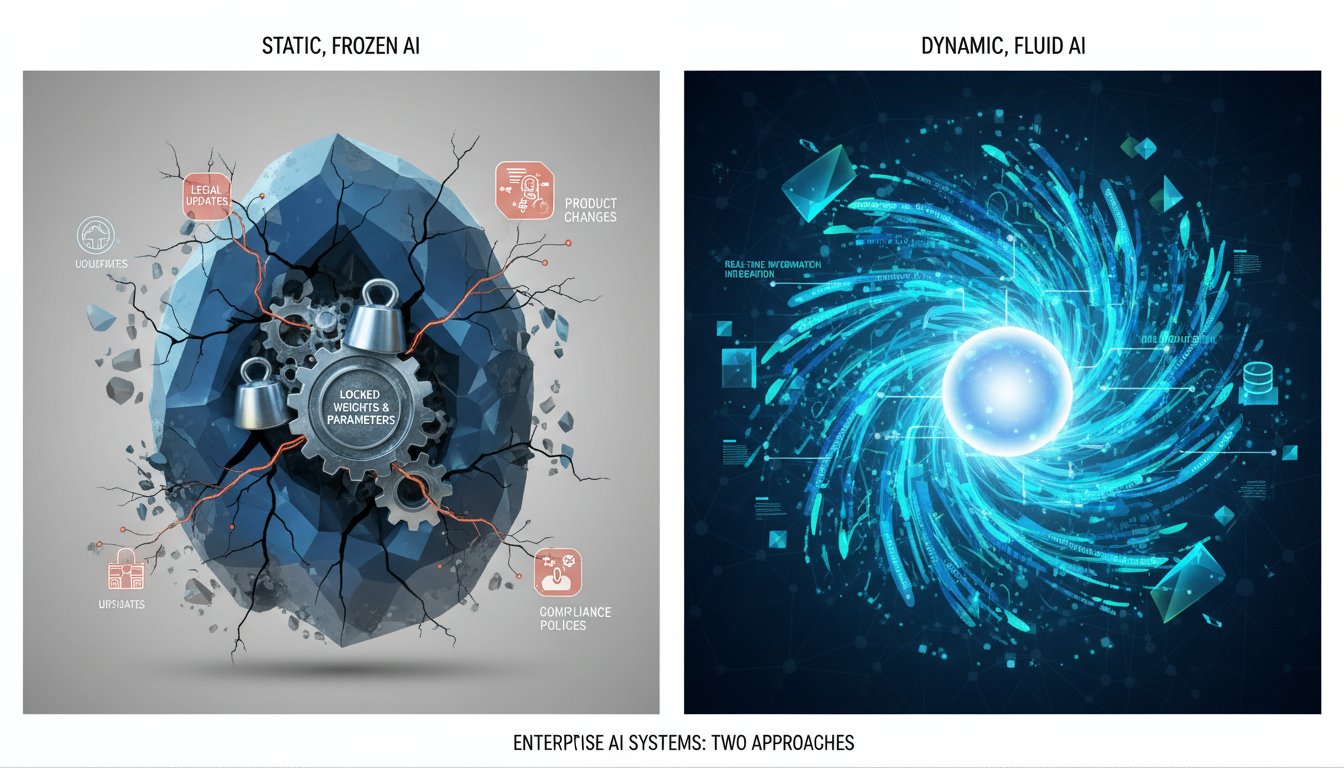Enterprise leaders are waking up to a harsh reality: their multi-million dollar AI investments are crumbling beneath poorly designed infrastructure. A recent study by Gartner reveals that 87% of enterprise RAG implementations fail to meet performance expectations, not because of inadequate models or data quality issues, but due to fundamental infrastructure oversights that were baked in from day one.
The problem isn’t just about choosing the wrong vector database or misconfiguring embedding models. It’s about a systemic misunderstanding of how modern AI infrastructure should be architected for enterprise scale. Companies are treating RAG systems like traditional software applications, applying decades-old infrastructure patterns to cutting-edge technology that demands entirely different approaches.
This infrastructure crisis is costing organizations more than just money—it’s eroding trust in AI initiatives across entire enterprises. When a RAG system takes 30 seconds to retrieve relevant documents or consistently returns irrelevant results, the problem often traces back to infrastructure decisions made months earlier by teams who didn’t fully understand the unique demands of vector operations and semantic search at scale.
The solution lies in understanding the five critical infrastructure pillars that separate successful enterprise RAG implementations from the failures. These aren’t theoretical concepts—they’re battle-tested principles derived from analyzing hundreds of enterprise deployments across industries ranging from financial services to manufacturing.
The Hidden Infrastructure Dependencies That Break RAG Systems
Most organizations approach RAG infrastructure the same way they’ve always built applications: start with compute, add storage, configure networking, and hope for the best. This traditional approach fails catastrophically when applied to RAG systems because it ignores the unique computational patterns that define modern AI workloads.
Vector Operations Require Specialized Hardware Architecture
Vector similarity searches operate fundamentally differently from traditional database queries. While a SQL query might touch a few thousand rows, a vector search evaluates mathematical relationships across millions of high-dimensional points simultaneously. This difference demands infrastructure that can handle massive parallel computations with consistent low latency.
The mistake most enterprises make is assuming that powerful CPUs or even standard GPUs can handle these workloads efficiently. Research from Stanford’s AI Infrastructure Lab shows that purpose-built vector processing units can deliver 40x better performance per dollar compared to general-purpose hardware for RAG workloads.
Enterprise-grade vector databases like Pinecone and Weaviate have recognized this reality, optimizing their infrastructure specifically for vector operations. However, many organizations still try to run these systems on traditional cloud instances, creating a fundamental mismatch between workload requirements and available resources.
Memory Hierarchy Optimization Is Non-Negotiable
RAG systems generate unique memory access patterns that can overwhelm traditional caching strategies. Unlike web applications where data access follows predictable patterns, RAG systems create dynamic memory requirements that scale with query complexity and corpus size simultaneously.
Successful enterprises architect their RAG infrastructure with multi-tiered memory hierarchies that can adapt to these dynamic patterns. This means designing systems where frequently accessed embeddings live in high-speed memory, while less common vectors remain in optimized storage tiers that can be retrieved with minimal latency impact.
The companies getting this right are seeing query response times under 200 milliseconds even with billion-vector corpora, while organizations using traditional memory management strategies struggle to achieve sub-second responses with much smaller datasets.
The Networking Revolution: Why Standard Cloud Networking Kills RAG Performance
Cloud providers have optimized their networking infrastructure for typical enterprise workloads: predictable traffic patterns, modest bandwidth requirements, and tolerance for occasional latency spikes. RAG systems break all of these assumptions, creating networking demands that can overwhelm even premium cloud networking services.
East-West Traffic Dominates RAG Architectures
Traditional applications primarily generate north-south traffic—data flowing between users and applications. RAG systems invert this pattern, generating massive east-west traffic as different components communicate during query processing.
When a user submits a query to a RAG system, the infrastructure must coordinate between embedding services, vector databases, document stores, and language models—often across multiple availability zones or regions. Each coordination step adds latency, and standard cloud networking isn’t optimized for these communication patterns.
Leading enterprises are solving this challenge by implementing specialized networking architectures that prioritize east-west bandwidth and minimize inter-service latency. Some are even deploying dedicated networking infrastructure that treats RAG components as a unified system rather than discrete services.
Bandwidth Requirements Scale Non-Linearly
As RAG systems grow in complexity—more documents, larger context windows, multi-modal inputs—their bandwidth requirements don’t just increase proportionally. They explode exponentially because each additional component creates multiple new communication pathways.
A RAG system handling 1,000 queries per minute might operate efficiently on standard cloud networking. The same system scaled to 10,000 queries per minute often becomes completely unusable without specialized networking infrastructure, even though the compute and storage resources are theoretically sufficient.
Storage Architecture: The Foundation That Everything Else Depends On
Storage decisions made during initial RAG implementation create cascading effects that determine system performance for years. Unlike traditional applications where storage primarily affects data durability and backup strategies, RAG storage architecture directly impacts query latency, system scalability, and operational costs.
Vector Storage Patterns Break Traditional Assumptions
Vector embeddings create unusual storage access patterns that confound traditional storage optimization strategies. While relational databases typically access data sequentially or through well-defined indexes, vector operations require random access to high-dimensional data points distributed across the entire storage system.
This pattern means that storage solutions optimized for sequential throughput—including many cloud storage services—deliver poor performance for RAG workloads. Successful enterprises architect their storage specifically for random access performance, often accepting lower sequential throughput in exchange for consistent low-latency random operations.
Data Locality Becomes Critical at Scale
As RAG systems scale beyond proof-of-concept implementations, data locality emerges as a critical performance factor. Systems that worked perfectly with million-vector datasets can become unusable when scaling to billion-vector corpora, not because of insufficient storage capacity, but because data locality optimizations weren’t considered during initial architecture decisions.
Enterprise RAG systems that maintain high performance at scale implement sophisticated data placement strategies that ensure related vectors remain physically proximate in storage. This might seem like a minor optimization, but it can mean the difference between 100-millisecond and 10-second query response times.
The Orchestration Challenge: Managing Complex AI Workloads
RAG systems consist of multiple interconnected components that must be orchestrated with precision to deliver consistent performance. Traditional container orchestration platforms like Kubernetes were designed for stateless web applications, not the complex, stateful workloads that define enterprise RAG architectures.
Resource Allocation Requires AI-Specific Logic
Standard orchestration platforms allocate resources based on CPU and memory utilization patterns observed in traditional applications. RAG workloads create entirely different resource utilization patterns that can fool traditional auto-scaling logic into making counterproductive decisions.
For example, a RAG system might show low CPU utilization while vector operations are bottlenecked by memory bandwidth. Traditional orchestration would scale down compute resources exactly when the system needs more specialized hardware to handle the workload effectively.
Successful enterprises implement AI-aware orchestration that understands the unique resource requirements of vector operations, embedding generation, and large language model inference. This might mean developing custom orchestration logic or implementing specialized platforms designed specifically for AI workloads.
State Management Complexity Multiplies
Unlike stateless web applications, RAG systems maintain complex state across multiple components. Vector indexes, model caches, and document stores all maintain state that must be coordinated during scaling operations, updates, and failure recovery.
Traditional orchestration platforms treat each component independently, which can lead to state inconsistencies that corrupt RAG system performance. Some enterprises have experienced complete system failures when standard orchestration logic attempted to scale RAG components without understanding their interdependencies.
Building Future-Proof RAG Infrastructure
The enterprises succeeding with RAG at scale aren’t just solving today’s infrastructure challenges—they’re building systems that can adapt as AI technology continues evolving. This requires infrastructure architecture principles that account for the rapid pace of change in the AI landscape.
Future-proof RAG infrastructure emphasizes modularity and composability over monolithic optimization. Rather than building systems optimized for today’s models and use cases, successful enterprises create infrastructure platforms that can adapt to new vector databases, embedding models, and AI architectures as they emerge.
This might mean accepting slightly lower performance today in exchange for the flexibility to integrate next-generation AI technologies without complete infrastructure overhauls. Given the pace of AI advancement, this trade-off often proves prescient within months of initial implementation.
The infrastructure crisis in enterprise RAG isn’t going to resolve itself through incremental improvements or hoping that cloud providers will eventually optimize for AI workloads. It requires fundamental changes in how organizations approach AI infrastructure architecture, moving beyond traditional patterns to embrace the unique demands of vector operations and semantic search at scale.
Organizations that address these infrastructure fundamentals now will establish competitive advantages that compound over time, while those that continue applying traditional infrastructure patterns to AI workloads will find themselves increasingly unable to compete in an AI-driven marketplace. The choice isn’t whether to invest in proper AI infrastructure—it’s whether to do it proactively or reactively after current systems have already failed.




